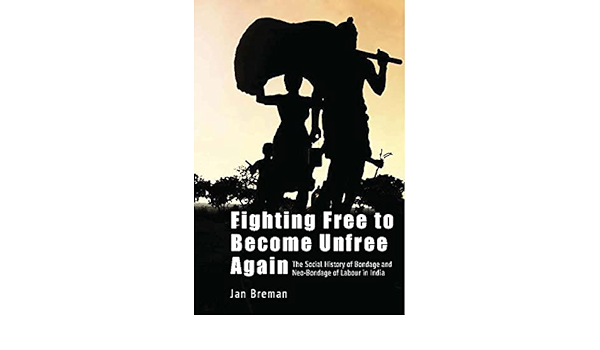
Jan Breman’s book Fighting Free to Become Unfree Again: The Social History of Bondage and Neo-Bondage of Labour in India, published by Tulika Books in 2023, is a riveting account of altering the framework of bondage in colonial and post-colonial India. What makes the book even more remarkable and distinctive is the author’s chronicle from a deeply personal experience of poverty, his acknowledgement of gaps from his early years of scholarship on rural relations of labour in south Gujarat, and more pronounced articulation on the coalesce of caste with slavery, exploitation of labour and bondage of the rural poor from lower caste communities. A masterful recollection of the six-decades-long research on bondage in India.
The book begins with Jan Breman’s memoir of his family in abject poverty until the second half of the twentieth century and his own experiences as a young boy growing up in a working-class neighbourhood which witnesses gradual improvement in the standards of living made possible by the instrumentation of the welfare state. With this premise that native economies and the poor have followed the same path apropos progress as that taken in the western hemisphere a century earlier, Breman shares why the same did not happen in post-colonial India, and how neoliberal capitalism is culpable of riding on pre-existing social divisions and worsening the plight of the labouring poor in the country.
As a young PhD student, when Breman had first come to India for fieldwork, he writes, how he only had a faint idea of the research. His dissertation, ‘Master and Servant’ examined the origin of labour bondage in the peasant economies in the subcontinent and tells the story of the collapsing inter-relationship between the Hindu caste landowners and the attached Dublas [one of the tribal communities in south Gujarat] post-independence by the intrusion of capitalism. Nevertheless, in the intervening years since, after making many visits to south Gujarat to further investigate the changing rural labour relations, the lives of the rural proletariat as footloose labour in the informal economy, and the changing social fabric in the countryside, Breman writes of the common denominator of subjection which has remained constant.
Caste is the focal point of slavery, bondage, and labour exploitation in India. However, most experts on bonded labour only call out the caste of the victim to accentuate multiple vulnerabilities. While these vulnerabilities of the members of Schedule Caste and Scheduled Tribe communities are real, casteism as an oppressive system which foreruns bondage is not adequately emphasised. Breman’s book bridges that gap which the Savarna scholars on bonded labour in India obscure. He categorically calls out the role of upper caste classes in preventing the abolition of slavery and bondage in India in myriad ways both during colonial and post-colonial times. In chapter two, Breman details the questionable attitude and unavailing approaches to bonded labour eradication of many nationalist leaders including Gandhi and Sardar Patel. After independence, the excuse to disapprove of a concrete government order or legislation to arrest labour exploitation and bondage, like their colonial counterpart, he says, was to not antagonise the powerful high-caste landowners.
When Breman commenced his research in the 1960s, Hali-Pratha according to him had disintegrated in the preceding decades, and the superiority of the dominant caste-class was no longer accepted. Nevertheless, Breman maintains that the features of bondage insisting on stagnating low wages and minimal survival, in the changed political economy, were equally vigorously upheld. In chapters three and four, Breman takes the reader through his fieldwork findings from 1962-63, and 1986-87, to show how the transformation of an agrarian economy into capitalism has only further intensified the exploitation of the lower caste labourers as the main functionaries of the democratic system from top to bottom, remained unchanged.
One of the most fascinating parts of this book is the brazen calling out of the state’s collusion with the high-caste elites in subjugating the labouring poor in relationships of neo-bondage. Breman minces no words in connecting the problem of the proletarianized masses in India to the undiluted authoritarianism stemming from the culture of caste, and not the country’s Constitution. He highlights how the state machinery’s interventions in rural labour relations, as in most interventions, are tuned to the interests of the elite. While most narratives on bonded labour capture the pathos of the system in which the victims find themselves stuck unable to break free, it’s refreshing to have Breman in the book pinning accountability of the dominant castes who strategise attachment in debt to secure the labour-power of the landless caste, be it local labour or migrants, to keep them perpetually locked in a state of dire improvidence, if not destitution, in all realms of informalised employment.
***
Madhuri Xalxo is a PhD student at the School of Law, SOAS University of London.
[…] post Rural Labour in a Caste Polity: Fighting Free to Become Unfree Again by Jan Breman (2023): A Review … appeared first on Doing […]